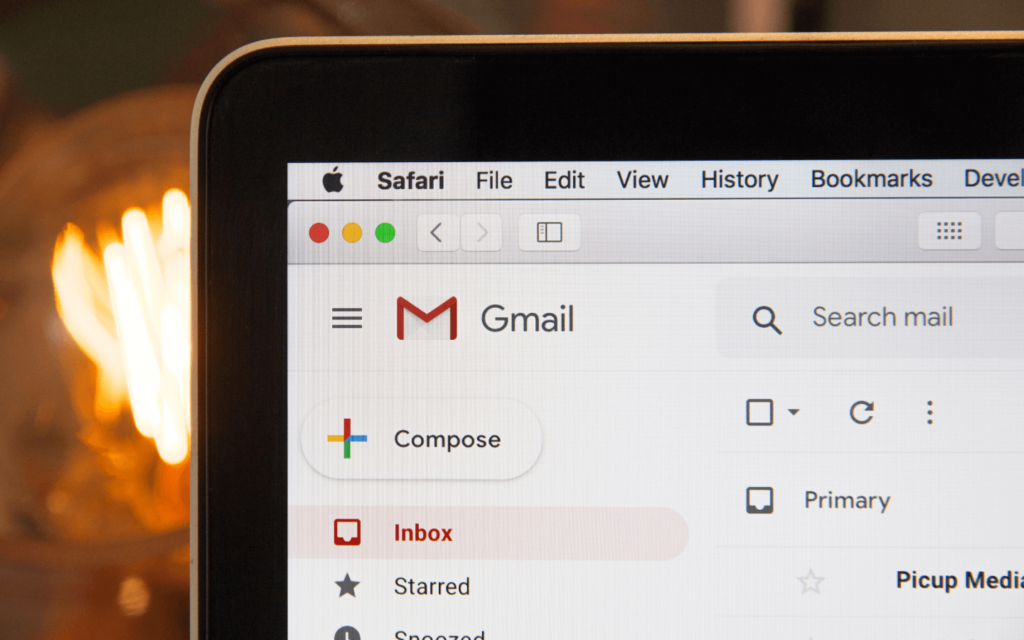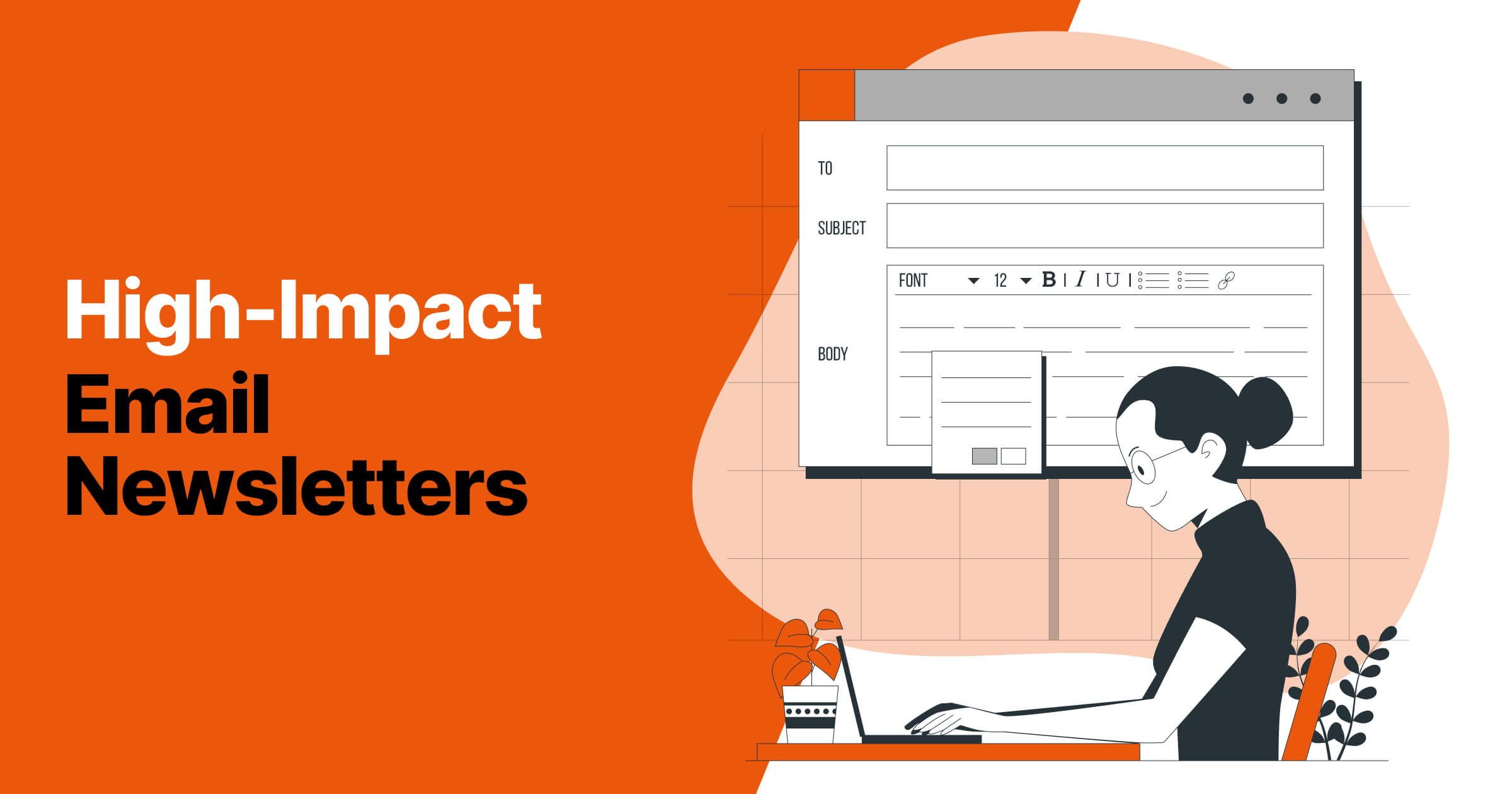The number of sent and received emails per day is projected to grow to 361.6 billion by 2024, suggesting a significant increase in email traffic and opportunities for engagement. With inboxes becoming more crowded, your messages face immense competition for audience mindshare the instant they’re sent. Breaking through the noise to effectively capture attention and drive outcomes often comes down to metrics – specifically your ability to continually optimize newsletters based on data-driven insights.
But where do you start on the path toward high-performing email campaigns? This comprehensive guide explores the complete journey – from determining if newsletters align with business objectives, to developing optimized components tailored to reader behaviors, to unlocking advanced metrics instrumental for continual optimization over time.
77% of B2B firms use email newsletters, with 79% considering email the best distribution channel.
Mailbutler
Whether your goals entail driving website traffic, generating more leads, or directly building revenues, creating newsletters that captivate subscribers and prompt actions is critical. By taking a metrics-driven approach instead of relying solely on intuition, you can actively listen to performance indicators and systematically enhance impact. Join us as we transform your newsletter strategy, elevating beyond basic email tactics to data-informed excellence poised for long-term dominance. Let’s examine key questions to validate if committed resources toward newsletters make strategic sense.
Table of Contents

Section 1: Determining if Newsletters Align to your Business Goals
Embarking on an email newsletter campaign requires careful consideration of its alignment with your business objectives. Here’s a three-pronged approach to ascertain if investing in newsletters is a strategic match:
Industry Fit:
Investigate whether competitors are effectively using email newsletters. In industries where newsletters are prevalent, they can be a powerful tool for staying top-of-mind with your audience. Consider the nature of your industry – do your competitors’ newsletters drive engagement? Are customers in your sector receptive to receiving regular updates via email? Understanding these dynamics will help you determine if newsletters will resonate with your target audience.
Available Resources:
Assess whether your team has the necessary resources to create impactful newsletters. This involves more than just writing content; it includes designing visually appealing formats, managing email lists, integrating with email platforms, and most importantly, tracking and analyzing email marketing performance metrics. Do you have the bandwidth to consistently produce high-quality newsletters that can capture and sustain your audience’s attention over time?
Strategic Goals Alignment:
Most crucially, how do newsletters serve your broader business goals? Whether it’s increasing lead generation, enhancing customer engagement, driving sales, or building brand awareness, your newsletter strategy should be a cog in the wheel of your overall marketing machine. Link each aspect of your newsletter – from content to frequency – to specific email marketing key performance indicators that contribute to achieving these goals. This strategic alignment ensures that your newsletters are not just a communication tool but a driver of tangible business outcomes.
By meticulously evaluating these factors, you can avoid misallocating efforts in newsletter marketing if it doesn’t squarely fit into your customer engagement strategy or contribute to growth. However, if there’s a clear match across these aspects, you’re well-positioned to leverage newsletters as a potent tool in your digital marketing arsenal.

Section 2: Components of an Effective Email Newsletter
Email newsletters enable consistent relationship-building by sharing useful content like promotions, product updates, special offers and relevant articles over time. When leveraged effectively, they captivate subscriber mindshare leading to increased qualified traffic and revenues. But prior to investment, determining strategic alignment is critical.
| Competitor Analysis | Examine if peer companies in your industry currently utilize email newsletters. While not universally applicable, if competitors have adopted them, subscribers likely expect and engage with periodic communications. Studying competitors also provides initial ideas on content types, imagery, layouts and calls-to-action to test. |
| Resource Assessment | Creating quality content, designing visually appealing templates, technically integrating platforms and continually analyzing email marketing performance metrics involves extensive effort over the long-term. Honestly evaluate if your team can maintain newsletters at a high standard before overcommitting resources and budgets. |
| Goal Alignment | Newsletters must actively advance core objectives tied to lead generation, customer acquisition, retention or revenues. Establish a clear link between email marketing key performance indicators and broader growth initiatives before further prioritization. |
Carefully weighing these factors guards against diverting focus into email newsletters if the channel doesn’t demonstrate viable market fit. However, with alignments confirmed across all dimensions, the foundation is set for impactful development.

Optimizing Email Newsletter Components
Crafting an effective email newsletter goes beyond mere content creation; it’s about strategically piecing together elements that resonate with your audience and align with your marketing objectives. Here’s how to optimize each component for maximum impact:
Subject Line:
47% of email recipients decide whether to open an email based on its subject line.
Mailbutler
Your subject line is the gateway to audience engagement. It should be concise yet compelling, sparking curiosity or a sense of urgency to prompt opens. Experiment with different tones – be it humorous, direct, or intriguing – and use A/B testing to identify which styles yield the highest open rates. Remember, the right subject line varies depending on your audience demographics and industry norms.
Pre-Header Copy:
This snippet of text is your second chance to grab attention. It works in tandem with your subject line to provide a clearer preview of the email’s content. Effective pre-header text can enhance open rates by giving subscribers a compelling reason to delve into your message.
Content:
The heart of your newsletter is its content. Aim for a focused narrative or theme in each issue. Overloading your newsletter with diverse topics can dilute the impact and confuse readers. Balance informative content with promotional material, ensuring that each piece adds value to your reader’s day. Analyze past email performance metrics to understand what content types have resonated best with your audience.
Design and Layout:
A clean and intuitive design can significantly enhance reader engagement. Use whitespace strategically to guide the reader’s eye and make the content more digestible. Include relevant, high-quality visuals that complement your text without overwhelming it. The layout should guide readers naturally towards your call-to-action (CTA).
CTAs:
Your CTA is the bridge between subscriber engagement and business objectives. It should be prominently placed and visually distinct, encouraging readers to take the next step, whether it’s visiting a webpage, signing up for an event, or making a purchase. Test different CTA placements and designs to see which configurations drive the best conversion rates.
Preference Selection and Unsubscribe Options:
Empower your readers with preference options, allowing them to select the type of content they want to receive. This customization enhances relevance and engagement. Additionally, a visible unsubscribe button is essential for maintaining list hygiene and subscriber satisfaction. It ensures that your engagement metrics remain high, and your audience remains genuinely interested.
Testing and Optimization:
Continual testing is vital. Regularly experiment with different elements of your newsletter – from the subject line to the layout – to ascertain what resonates most with your audience. Use email performance metrics to guide your testing strategy and make data-driven decisions for ongoing improvement.
By meticulously crafting each component of your newsletter, you ensure that it not only captures attention but also sustains engagement, driving your audience closer to your desired business outcomes.

Section 3: Mastering email marketing performance metrics
Understanding and optimizing key email marketing performance metrics is more crucial than ever. It’s not just about sending out emails; it’s about making each one count. Let’s dive into the top metrics reshaping the email marketing landscape and how you can leverage them for unparalleled campaign success:
📈Open Rate:
The open rate remains a fundamental metric, revealing the percentage of recipients who open your emails. It’s a primary indicator of how effective your subject lines are and the overall appeal of your emails. In 2024, the average open rate stands at around 22.86%, serving as a benchmark for your campaigns.
💬Click-Through Rate (CTR):
The overall average email open rate across industries is 36.5%, with a 1.4% click-through rate.
Smart Insights
CTR measures the percentage of recipients who clicked on links within your email. It’s a deeper dive into engagement, going beyond just opening the email. This metric can help you understand which aspects of your content are most compelling, with an average CTR of 3.71% being a noteworthy figure to aim for.
🎯Conversion Rate:
This key metric indicates the percentage of recipients who take the desired action after clicking an email link, such as making a purchase or signing up for a webinar. Conversion rates directly measure the impact of your email campaigns on business goals.
🚫Bounce Rate:
Bounce rate reflects the percentage of emails that couldn’t be delivered. High bounce rates can negatively affect your sender’s reputation and email deliverability. Monitoring this ensures your emails are reaching the intended recipients.
📉List Growth Rate:
A healthy email list is crucial for successful campaigns. The list growth rate measures how quickly your subscriber list is expanding, indicating the effectiveness of your acquisition strategies.
🚪 Unsubscribe Rate:
This metric shows the percentage of recipients opting out of your email list. Keeping the unsubscribe rate low is vital for maintaining an engaged audience and ensuring your content stays relevant.
📤 Forwarding Rate:
Reflecting the virality of your emails, this metric counts how often your emails are shared or forwarded. It can extend your campaign’s reach and enhance brand visibility, indicating content resonance with your audience.
💰 Revenue per Email:
This metric calculates the average revenue generated from each email sent, offering insights into the ROI of your campaigns. It’s crucial for understanding the financial impact of your email marketing efforts.
🐞 Spam Complaint Rate:
The spam complaint rate measures how often your emails are marked as spam. It’s essential to monitor and address this to maintain a positive sender reputation and ensure deliverability.
🔄 List Churn Rate:
Measuring the rate at which subscribers leave your email list, this metric helps identify content or engagement issues. Reducing list churn is key to retaining subscribers and enhancing long-term campaign success.
Leveraging these metrics effectively requires a strategic approach. Begin by integrating advanced tools for tracking and analysis. Use this data to refine your content, design, and targeting strategies. Regularly review these metrics to identify trends and make informed decisions, optimizing your campaigns for higher engagement, better conversion rates, and increased ROI.
Embrace the evolving trends of email marketing such as personalization, user-generated content, AI-driven automation, and a focus on mobile optimization. By aligning your strategy with these emerging trends and rigorously monitoring your performance metrics, your email marketing campaigns can achieve outstanding results to drive your business forward.

Section 4: Strategies for Continual Email Metric Improvement
Continuously refining your email marketing tactics based on performance metrics is not just beneficial; it’s essential. Here are strategies to enhance your email marketing metrics for a more impactful reach and engagement:
Refine Subject Lines and Content:
- Regularly A/B test different subject lines and content variations. Analyze which versions yield higher open and click-through rates.
- Utilize emerging trends like AI-driven content creation to craft compelling narratives that resonate with your audience.
Optimize Call-to-Action (CTA) Elements:
- Experiment with varying CTA designs, placements, and messaging to see which configurations drive the best conversion rates.
- Interactive email elements can be a game-changer in increasing engagement and conversions.
Leverage Personalization:
- Employ data-driven personalization techniques to tailor your emails according to individual preferences, behaviors, and previous interactions. This approach can significantly boost open rates, engagement, and conversions.
Focus on Mobile Optimization:
Approximately 75% of Gmail users access their inboxes on mobile devices.
Mailbutler
- Ensure your emails are mobile-friendly, given the significant portion of emails opened on mobile devices. Responsive design is crucial for a seamless and engaging mobile experience.
Utilize Email Automation:
- Implement automated email workflows to nurture leads and engage customers with personalized content at the right moments.
- Welcome emails, abandoned cart reminders, and post-purchase follow-ups can be automated for efficiency.
Integrate User-Generated Content (UGC):
- Incorporate UGC like testimonials, reviews, and social media posts into your emails to add authenticity and trust, enhancing engagement and credibility.
Monitor Key Metrics:
- Keep a close eye on crucial KPIs like conversion rate, bounce rate, list growth rate, and spam complaint rate to gauge the effectiveness of your email campaigns.
Adapt to Privacy Regulations:
- Stay updated with privacy laws and ensure your email marketing practices comply. This builds trust with your audience and prevents legal issues.
Engage in Continuous Testing and Analysis:
- Regularly analyze your campaign data to identify trends and areas for improvement. Adjust your strategies based on insights gained from metrics like forwarding rate and revenue per email.
Reduce List Churn Rate:
- Implement strategies to retain your subscribers, such as re-engagement campaigns or feedback surveys, to lower your list churn rate and maintain a healthy, engaged email list.
By adopting these strategies and staying attuned to the latest trends and metrics in email marketing, you can ensure that your campaigns remain effective, engaging, and aligned with your audience’s evolving preferences. This proactive approach to continuous improvement will position your email marketing efforts at the forefront of success.

Section 5: Key Takeaways on Email Newsletter Excellence
In closing, a few core themes persist across the email newsletter landscape capable of elevating beyond basic messaging to breakthrough results:
🎯 Strategic Alignment and Continuous Evaluation:
- Ensure that your newsletter strategy aligns with your overall business goals and industry trends. Regularly assess the strategic fit of your newsletters in light of emerging market dynamics and evolving customer preferences.
⚙️ Dynamic Component Optimization:
- View your newsletter as a flexible tool, open to continuous refinement. Utilize A/B testing to fine-tune every aspect, from subject lines to CTAs, based on performance metrics like open rates, click-through rates, and conversion rates.
📊 Embracing Advanced Metrics for In-Depth Insights:
- Go beyond basic metrics. Focus on advanced KPIs such as engagement rates, list growth rate, and revenue per email. These metrics provide a deeper understanding of the effectiveness and financial impact of your email campaigns.
🔮 Incorporating Latest Trends to Enhance Engagement:
- Stay ahead by incorporating the latest trends in email marketing. Use AI for personalized content, integrate user-generated content for authenticity, and ensure your emails are mobile-friendly to cater to the majority of users accessing emails on mobile devices.
🛡️ Prioritizing User Privacy and Trust:
- In an era where privacy is paramount, ensure your email marketing practices are transparent and comply with data protection laws. This approach not only builds trust but also enhances the credibility of your brand.
🕵️♀️ Adopting a Holistic View of Performance:
- Evaluate your email campaigns from a holistic perspective. Consider how each element from content to design contributes to overall performance and aligns with your marketing objectives.
🧠 Commitment to Continual Learning and Adaptation:
- The landscape of email marketing is constantly changing. Commit to ongoing learning and adaptation. Regularly update your strategies based on the latest data, trends, and technological advancements to maintain relevance and effectiveness.
By internalizing these key takeaways and applying them diligently, your email newsletters can transcend beyond mere communication to become a powerful tool for engagement, conversion, and brand building. Remember, the journey to email excellence is continuous, driven by a relentless pursuit of improvement, adaptation, and strategic alignment.

Further Your Digital Marketing Education
If, after reviewing this guide, you determine email newsletters are not the right tactic for your business at this juncture, plenty of additional fruitful digital marketing avenues exist to explore.
Consider tapping into other rapidly evolving channels like:
Social Media Marketing: Harness platforms like Facebook, Instagram and LinkedIn to engage audiences and promote content.
Search Engine Optimization: Organically raise your visibility in search engines like Google to increase website traffic.
Pay-Per-Click Advertising: Utilize paid ads to reach new customers actively searching for related products or services.
Content Marketing: Build loyalty and trust by consistently delivering valuable, relevant content.
We cover the essential components for excelling across all major digital marketing channels. To further your knowledge, take time to explore our blog and resources focused on industry best practices. Discover which strategic mix of digital tactics aligns closest to your business goals and available resources.
More on Email Marketing Performance Metrics
What growth is projected for email traffic by 2024?
By 2024, daily email traffic is expected to reach 361.6 billion, indicating a significant increase in opportunities for engagement.
Why is it challenging to capture attention with email newsletters?
With crowded inboxes, your emails face immense competition, making it challenging to stand out and capture audience attention.
What role do metrics play in optimizing email newsletters?
Metrics are crucial for continually optimizing newsletters, as they provide data-driven insights that guide improvements.
How prevalent are email newsletters in B2B firms?
77% of B2B firms use email newsletters, and 79% consider email the best distribution channel.
What are the strategic considerations before starting an email newsletter campaign?
Consider industry fit, available resources, and how newsletters align with your broader business goals.
What is the average open rate for emails in 2024?
In 2024, the average open rate for emails is around 22.86%.
How important is the subject line in email marketing?
The subject line is critical, as 47% of recipients decide whether to open an email based on its subject line.
What is a good click-through rate (CTR) for email newsletters?
A noteworthy CTR to aim for is 3.71%, though it varies by industry.
How does personalization impact email marketing effectiveness?
Personalization tailors emails to individual preferences, significantly boosting open rates, engagement, and conversions.
Why is mobile optimization crucial in email marketing?
With approximately 75% of Gmail users accessing their inboxes on mobile devices, responsive design is crucial for engagement.
What is the role of user-generated content (UGC) in emails?
UGC, like testimonials and social media posts, adds authenticity and trust, enhancing engagement and credibility.
How do privacy regulations impact email marketing?
Compliance with privacy laws builds trust with the audience and prevents legal issues, maintaining brand credibility.
What is the significance of list churn rate in email marketing?
List churn rate measures subscriber loss, helping identify content or engagement issues for retention strategies.
How should one approach continual learning in email marketing?
Stay updated with latest data, trends, and technological advancements to maintain relevance and effectiveness.
Are there alternative digital marketing channels if email newsletters aren’t suitable?
Yes, options include social media marketing, search engine optimization, pay-per-click advertising, and content marketing.
